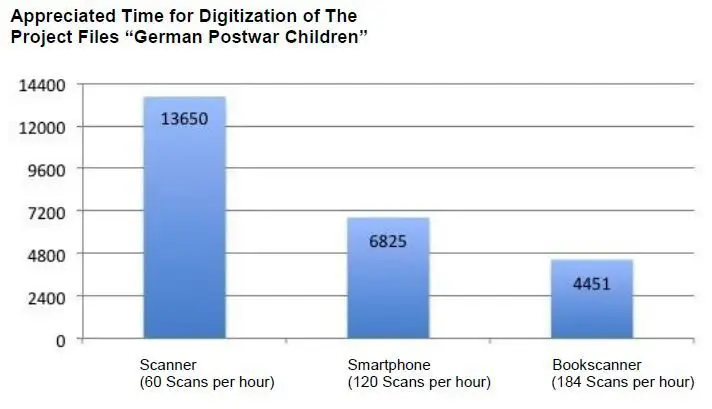Evaluating the zeta Book Scanner: A Student’s Study
November for Crowley Conversions is all about measurable results. Last week, we compared the Mekel Technology microfilm and microfiche scanners to competitive models and found measurable ROI. This week, we’re reviewing a blog written by Sascha Foerster. In it, he compares the Zeutschel zeta book copy and scan system to other methods used to scan a historic file collection.
From German Post-War studies to German engineering

As background, Foerster is a doctoral candidate at the University of Bonn’s Center for Aging Cultures in Germany. He authored a blog titled “File Digitization For Beginners (or: A Brief History Of Rapid Technical Development).”[1] As a student assistant in 2009, Foerster began helping a research group with the scanning of documents related to the “German Post-War Children’s Study, 1951-1962.”[2]
Four years and deep into the project later, Foerster’s blog records his comparison of the three different scanning methods he employed. As one reads the translation, it becomes clear that project budget was minimal and that the advances in scanning technology over that short time were immense. Foerster compares his use of a flatbed scanner, smartphone scanner and a zeta book scanner.
Findings
According to Foerster’s findings, the flatbed scanner was too slow. He then created a makeshift smartphone scanner by mimicking the design for a box which allowed for internal lighting and prevented the phone from shaking in his hand. This smartphone scanner didn’t provide enough post-processing options (and the image quality varied greatly depending on external lighting). But the Zeutschel zeta was just right. The zeta’s advanced scanning technology and easy, quick scanning methodology made it the obvious choice for this digitization project.[3]
To quantify the comparisons, Foerster began by measuring approximately how many scans could be completed on each scanner per hour. The zeta performed at a rate of 184 scans per hour. He then considered the total amount of records in the collection: there are 4095 records, each containing approximately 100 file sheets for an estimated total of 409,500 documents. Foerster created the graph below to illustrate the time it would take to complete the digitization project using each scanner. Using his experience and assumptions, the Zeutschel zeta was the clear winner.

Foerster noted that, using the zeta, “The scanning process itself is really very convenient and as fast as lightning.” He also wrote about other features he admired, including the sleek design, range of output options and automatic finger removal from the image. He explained this last feature by observing, “Fingers which keep hold of the sheet will be removed automatically from the scan.”
Status of the Study
We caught up with Foerster to ask him how the digitization and revitalization of the German Post-War Children study is coming along. He took time out of his busy schedule (studying for a PhD must not leave much time for leisure) to reply to us, stating, “Right now, after two years of searching, I found (with the financial help of the crowdfunding-community) more than half of the former participants, about 60 years after the beginning of the first study.” He continues, “The financial situation is still problematic. We are applying for funding but, up to now, we don’t know if it will work out soon even though there is a large interest in this study by the former participants, different research teams and the public. The small team of my professor, his assistant and I are preparing the next steps for the study, where I specialize on the digitization process of the files, so I can start with it as soon as funding is available. The former participants shall be researched again so a larger team can then do research on health, psychological and sociological questions, which can be compared to original data from early childhood for a study over the participants’ lifespan and maybe even start a new long-term study.”
See the zeta for Yourself
Watch this video for a glimpse of the zeta’s speed and ease-of-use:
Questions About the zeta or Other Zeutschel Book Scanners?
If you have any questions about the Zeutschel line of book copiers and large-format planetary scanners, or would like to arrange an on-site or web demo, please contact The Crowley Company by calling (240) 215-0224. General inquiries can be emailed to [email protected]. You can also follow The Crowley Company on Facebook, Twitter, Google+, LinkedIn, Pinterest and YouTube.
Editor’s Note: We often hear from clients who are looking to upgrade from a flatbed scanner or Multi-Function Device (MFD) to a more gentle, higher-quality scanning system and find the zeta to be an ideal solution. It’s great to be able to show quantitative evidence of how the zeta is faster, at least in this instance, in addition to its more advanced features and flexibility (and even better that someone did the comparisons for us – thanks Sascha!)
Author

[1] An English translation of “Aktendigitalisierung für Anfänger.Oder: Die kurze Geschichte einer rasanten technischen Entwicklung” (http://zakunibonn.hypotheses.org/1119) by Sascha Foerster. Use of this blog and its contents is authorized under the Creative Commons Attribution 4.0 International license.
[2] http://zakunibonn.hypotheses.org/59
[3] The zeta is not considered a true archival preservation scanner, although it can produce images with up to 600 dpi resolution. Zeutschel’s 12002, 14000 and 15000-series scanners are suggested for archival preservation projects.
